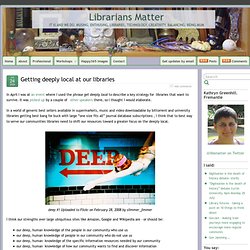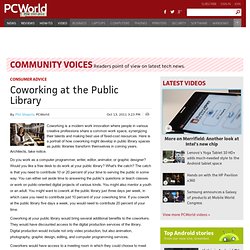

Infonet. The 'Excellent Customer Service in Public Libraries - New Trends' seminar was held on Thursday 2 April 2009, at the State Library of Victoria.

It is part of the professional development delivered as part of the Statewide Public Library Development Projects. The audience from Victorian public libraries heard from three interstate speakers: Brett Whitford, Executive Director, Customer Service Institute of Australia (CSIA) who spoke about Changing customer service trends; Sharan Harvey, Manager, Brisbane City Council Library Service, delivered presented on the customer focus at Brisbane Square Library and Customer Centre; and Carina Clement, Manager, Albury LibraryMuseum spoke about the pros and cons of convergence and the impact on customer service at the Albury LibraryMusuem.
Reading Future Trends, Libraries Reach Out to Older Adults. May 16, 2011; Source: SecondAct | Some enterprising public libraries around the country think there's much more they can do to serve aging baby boomers.

As a result, they're starting programs and making other changes designed to cater to the interests and needs of adults between the ages of 50 and 75, a group that's projected to represent 65 percent of U.S. library patrons by 2014. In California, where up until a few years ago the state's library system offered few programs for "mid-life adults," the Transforming Life after 50 (TLA50) initiative now offers training and guidance on the kinds of programs and resources that would appeal to active, older adults.
Stephen Risau, a Portland, Ore., consultant who helped on the TLA50 initiative, says that it's in the best of interest of libraries "to change because boomers are living extended lives and have active lifestyles, and they're looking for not only how they could participate in programs but increasing how they might contribute. " Getting deeply local at our libraries. In April I was at an event where I used the phrase get deeply local to describe a key strategy for libraries that want to survive.

It was picked up by a couple of other speakers there, so I thought I would elaborate. In a world of generic best sellers available in supermarkets, music and video downloadable by bittorrent and university libraries getting best bang for buck with large “one size fits all” journal database subscriptions , I think that to best way to serve our communities libraries need to shift our resources toward a greater focus on the deeply local. JeromeDL - the Semantic Digital Library. Educational Technology and Libraries.
Resourceful Curriculum for 21st Century Learning: Designing the School Library as a Garden. Libraries as Sites of Enchantment, Participatory Culture, and Learning. R. David Lankes. New York’s Public Architecture Gets a Face-Lift. Library 2.0 - the future of libraries in the digital age. Changing Spaces: Exploring Future User Needs, Sustainability, and Value. BuildingAndFacilities. Design Institute: Six Space Challenges from Six Libraries. Digital library aims to expand kids' media literacy. CHICAGO – On the ground floor of the city's main library, an odd experiment is taking place, one that could determine what your neighborhood library looks like in 10 years.

It goes like this: Take a very large room and fill it with the latest digital media — laptop computers, music keyboards, recording equipment, video cameras and gaming consoles. Invite teenagers. Apply a little pressure, pushing them both to consume and produce media. Watch what happens. Once a storage room at the Harold Washington Library Center, the high-ceiling, 5,500-square-foot space, dubbed "YOUmedia — a Digital Library Space for Teens," has become a magnet for young people citywide, so popular and influential that the library plans to replicate it citywide.
PHOTOS: New library a digital space for teens The original space, sitting in the shadow of the downtown Loop, sees a steady stream of visiting librarians, educators and scholars. Funded in part by the Chicago-based John D. and Catherine T. Coworking at the Public Library. Coworking is a modern work innovation where people in various creative professions share a common work space, synergizing their talents and making best use of fixed-cost resources.

Here is a portrait of how coworking might develop in public library spaces as public libraries transform themselves in coming years. Architects, take notice. Do you work as a computer programmer, writer, editor, animator, or graphic designer? Would you like a free desk to do work at your public library? What's the catch? Coworking at your public library would bring several additional benefits to the coworkers.
Coworkers would have access to a meeting room in which they could choose to meet with other coworkers for a given number of hours each week. The benefits of coworking at a public library would be such that they would strongly attract someone who would otherwise be working in the solitary environment of their home. What would an ideal librarian in this setting look like? – Phil Shapiro.